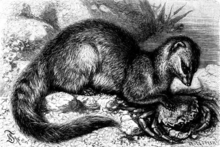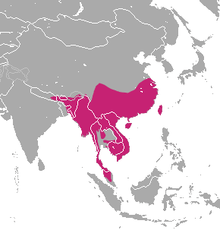Crab-eating mongoose
| Crab-eating mongoose[1] | |
|---|---|
 | |
| Scientific classification | |
| Kingdom: | Animalia |
| Phylum: | Chordata |
| Class: | Mammalia |
| Order: | Carnivora |
| Family: | Herpestidae |
| Subfamily: | Herpestinae |
| Genus: | Herpestes |
| Species: | H. urva |
| Binomial name | |
| Herpestes urva Hodgson, 1836 | |
 | |
| Range | |
The crab-eating mongoose (Herpestes urva) is a mongoose species ranging from the northeastern Indian subcontinent to Southeast Asia, southern China and Taiwan. Throughout its wide range there are many languages and therefore various common names for the species. In particular, according to at least some major dictionaries, the source of the species name urva (which at one time was also the name of the genus, as in: Urva urva) was the Nepali language urvá or arvá[3][4]
Characteristics
H. urva is generally grey in color, with a broad white stripe on its neck extending from its cheeks to its chest. Its throat is steel-gray with white ends of its hair, rendering a salt and pepper appearance. Its hind feet possess hairy soles. Its tail is short and homogeneously colored with a fairer tip. The body of the crab-eating mongoose is 36–52 cm (14–20 in) in length, and 1–2.3 kg (2.2–5.1 lb) in weight.[5]
Distribution and habitat
Crab-eating mongooses are common in Vietnam, Laos, Cambodia, Thailand, Peninsular Malaysia, northern Myanmar and northeastern India. They are rare in Bangladesh.[2] In Nepal, this species inhabits subtropical evergreen and moist deciduous forests, and has also been observed on agricultural land near human settlements.[6]
Ecology and behaviour
Crab-eating mongooses are usually active in the mornings and evenings, and were observed in groups of up to four individuals. They are supposed to be good swimmers, and hunt along the banks of streams and close to water.[7]
Despite their common name, their diet consists not only of crabs, but also just about anything else they can catch, including fish, snails, frogs, rodents, birds, reptiles, and insects.[6]
Conservation
Herpestes urva is listed in CITES Appendix III.[2] It is listed as Least Concern by the IUCN.[2]
References
- ↑ Wozencraft, W.C. (2005). "Order Carnivora". In Wilson, D.E.; Reeder, D.M. Mammal Species of the World: A Taxonomic and Geographic Reference (3rd ed.). Johns Hopkins University Press. pp. 569–70. ISBN 978-0-8018-8221-0. OCLC 62265494.
- 1 2 3 4 Choudhury, A.; Timmins, R.; Chutipong, W.; Duckworth, J.W.; Mudappa, D.; Willcox, D.H.A. (2016). "Herpestes urva". IUCN Red List of Threatened Species. IUCN. 2016: e.T41618A86159618. Retrieved 10 November 2016.
- ↑ "urva." Merriam-Webster.com. 2016. (1 June 2016)
- ↑ Geddie, William (ed.); Chambers's Twentieth Century Dictionary; Pub: W. & R. Chambers, 1964
- ↑ Sheng, H., ed. (2005). Atlas of Mammals of China (in Chinese). Zhengzhou: Henan Science and Technoledge Press. p. 188. ISBN 7-5349-2936-9.
- 1 2 Thapa, S (2013). "Observations of Crab-eating Mongoose Herpestes urva in eastern Nepal" (PDF). Small Carnivore Conservation. 49: 31–33.
- ↑ Van Rompaey, H. (2001). The Crab-eating mongoose, Herpestes urva. Small Carnivore Conservation 25: 12–17,
Further reading
- Menon, V. (2003). A field guide to Indian mammals. Penguin India, New Delhi
External links
| Wikimedia Commons has media related to Herpestes urva. |
